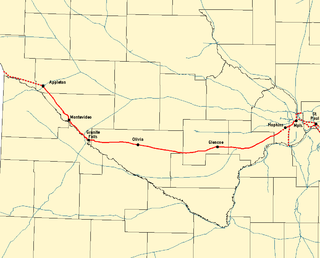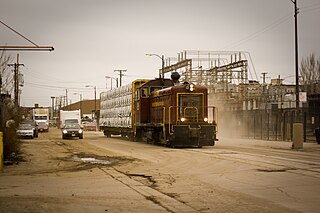Related Research Articles

The Chicago, Milwaukee, St. Paul and Pacific Railroad (ACMStP&P), better known as the Milwaukee Road, was a Class I railroad that operated in the Midwest and Northwest of the United States from 1847 until 1986.

Tacoma Rail is a publicly owned Class III shortline railroad. It is owned by the city of Tacoma, Washington and operated as a public utility. It is one of three operating divisions of the municipally-owned Tacoma Public Utilities service, but unlike other city services, the railroad is self-supported and generates revenue for the City of Tacoma and Washington state. Tacoma Rail provides freight switching services, serving the Port of Tacoma and customers in Tacoma, south Pierce County and parts of Thurston County. It operates 16 diesel locomotives, more than 100 employees and about 140 miles (230 km) of track, many of which are former Milwaukee Road and BNSF Railway lines around Western Washington.

Progressive Rail Inc. is a shortline railroad and owner of several other shortlines. PGR is directly operating several separate branches in Minnesota including the Airlake Terminal Railway. Progressive Rail also acquired the Wisconsin Northern Division in Chippewa Falls, Wisconsin and operates as a separately-named division. They also own the Chicago Junction Railroad, Clackamas Valley Railway, the Iowa Traction Railway and Iowa Southern Railway in Iowa, the Crab Orchard and Egyptian Railroad in Illinois, the St. Paul & Pacific Northwest Railroad, and the Wisconsin Northern Railroad.

The Mt. Rainier Scenic Railroad or MRSR, formerly the Mt. Rainier Railroad and Logging museum (MRRR), is a steam-powered heritage railroad operating in the U.S. state of Washington between Elbe and Mineral. The railroad travels on trackage that passes through thick forest just south of Mount Rainier. The depot, gift shop and ticket office are located in Elbe. The train travels to the Logging Museum exhibits located in Mineral. The MRRR ran its collection of vintage rail equipment over 7 miles of track, part of Tacoma Rail's Mountain Division.
The Fort Smith and Western Railway was a railroad that operated in the states of Arkansas and Oklahoma.

The Central California Traction Company is a Class III short-line railroad operating in the northern San Joaquin Valley, in San Joaquin County, California. It is owned jointly by the Union Pacific and BNSF Railway.
The Ware Shoals Railroad was a shortline connecting the town of Ware Shoals, South Carolina, to the Southern Railway and Piedmont and Northern Railway at Shoals Junction, South Carolina, a distance of 5.2 miles (8.4 km).

The Twin Cities and Western Railroad is a railroad operating in the U.S. state of Minnesota which started operations on July 27, 1991. Trackage includes the former Soo Line Railroad "Ortonville Line", originally built as the first part of the Pacific extension of the Milwaukee Road. This main line extends from Hopkins, Minnesota ,to Appleton, Minnesota. The line was originally built between Hopkins and Cologne, Minnesota, in 1876 by Hastings and Dakota Railroad. In 1913, the Milwaukee Road rerouted it, reducing the curves. The line was eventually extended to the Pacific.
The Washington County Railroad is a shortline railroad operating in Vermont and a sliver of New Hampshire, forming part of the Vermont Rail System. The WACR began operating in 1980 over the old Montpelier and Barre Railroad in Washington County, which the state acquired to ensure the continuance of rail service, and ceased operations in early 1999. Later that year, after interim service by other companies, operations were transferred to a new WACR subsidiary of the Vermont Rail System. In 2003, operations were greatly expanded through acquisition by the state and operation by the WACR of a former Boston and Maine Corporation and Canadian Pacific Railway line between Newport and White River Junction, which had most recently been operated by subsidiaries of the bankrupt Bangor and Aroostook Railroad.

The Iowa Northern Railway is a Class III shortline railroad operating in the U.S. state of Iowa.
Central Montana Rail, Inc. is a short line railroad operating trackage in Judith Basin, Fergus, and Chouteau Counties, Montana. The company's main line extends approximately 84.2 miles (135.5 km), between the towns of Moccasin and Geraldine; the line connects with the BNSF Railway at Moccasin.

The Chicago Terminal Railroad was a switching and terminal railroad that operated over former Milwaukee Road/Canadian Pacific and Chicago and North Western/Union Pacific trackage in northern Illinois. The railroad began its operations on January 2, 2007. The railroad rostered a total of three locomotive units, all of EMD design.

The Central New York Railroad is a shortline railroad operating local freight service along ex-Southern Tier Line trackage in New York and Pennsylvania.

The Yadkin Valley Railroad is the trade name of the Piedmont and Atlantic Railroad and is a shortline railroad operating two lines leased from the Norfolk Southern Railway originating out of Rural Hall, North Carolina for a distance of 93 miles (150 km). The railroad began operation in 1989 and is currently a subsidiary of Gulf and Ohio Railways.

The Tacoma Eastern Railroad was officially established by John F. Hart and George E. Hart in 1891. The enterprising lumberman received leases from Pierce County to harvest lumber from sections of a local school district. By 1890, most available timber near navigable water had been harvested. Sawmill industries had traditionally used the Puget Sound to float their wares to schooner captains, which could then be transported to markets, typically in San Francisco. To accommodate this new dilemma, the J.F Hart and Company began planning and construction for the Tacoma Eastern Railroad.
The Western Kentucky Railway was a shortline railroad in Kentucky, that connected coal mines with CSX Transportation at Providence. The lines were part of the Illinois Central Gulf Railroad until March 1982, when Costain Coal, Inc. bought the trackage and set up the Tradewater Railway to operate it. In January 1995, the Rail Management and Consulting Corporation acquired the property and transferred it to the new Western Kentucky Railway. Genesee & Wyoming Inc. acquired it from the Rail Management Corporation in 2005. In 2010, WKRL abandoned all of its remaining lines north of Providence, and the rails were removed shortly after. The only remaining tracks that were originally owned by WKRL are operated by Martin Marrieta Aggregates' Fredonia Valley Railroad from Princeton to Fredonia.
The Council Bluffs and Ottumwa Railway was a shortline Class III railroad that handled freight switching operations in Council Bluffs, Iowa. It operated from August 1989 until May 1991, when it was sold to the Council Bluffs Railway, an OmniTRAX subsidiary.
The Chicago and St. Louis Railway was a predecessor of the Atchison, Topeka and Santa Fe Railway that owned a line between Chicago and Pekin, Illinois. More than half of the line is now part of the BNSF Railway's Southern Transcon.

The Laurinburg and Southern Railroad is a short-line railroad operating in North Carolina. The railroad has 28 mi (45 km) of track that runs south from Raeford to Laurinburg, North Carolina and industries to the south. However, much of the line is out of service, and sections at either end are used for car storage. In the past, the Laurinburg and Southern controlled a number of other small railroads in North Carolina and Virginia. The railroad has been owned by Gulf and Ohio Railways since 1994.
The St. Maries River Railroad is a shortline Class III railroad that operates 71 miles of freight service in northern Idaho. From 1980 until 2010, it was a subsidiary of Potlatch Corp.
References
- ↑ Lewis, Edward A. (1975). American Short Line Railway Guide. The Baggage Car. p. 103.
- 1 2 3 4 5 "Western Rails - Weyerhaeuser CW / Vail / CM&E".
- ↑ Hoxit, Eric (February 19, 1976). "Wil old covered bridge find new home at fair?". The Daily Chronicle . p. 1. Retrieved November 18, 2024.
- ↑ Lewis, Edward A. (1978). American Short Line Railway Guide. The Baggage Car. p. 115.
- ↑ Lewis, Edward A. (1991). American Short Line Railway Guide. Kalmbach Books. p. 302.
- ↑ Lewis, Edward A. (1996). American Short Line Railway Guide. Kalmbach Books. p. 356.
- 1 2 Trains magazine, July 1981, p. 18.
- ↑ Trains magazine, January 1982, p. 21.
- ↑ Lewis, Edward A. (1996). American Short Line Railway Guide. Kalmbach Books. p. 300.